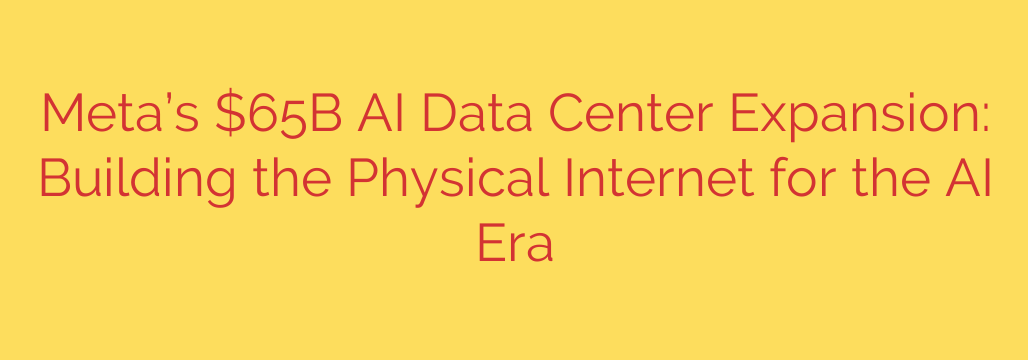
Building the Engine of Tomorrow: The Massive Infrastructure Fueling the AI Revolution
The race to dominate the future of artificial intelligence isn’t just about writing smarter algorithms; it’s a colossal undertaking to build the physical foundation that will power them. We are witnessing an unprecedented investment in the hardware and data centers that form the very backbone of the AI era—a project of such scale it can be described as building the physical internet for AI.
At the heart of this technological push is a clear and ambitious goal: to construct one of the most powerful AI infrastructures on the planet. This isn’t a minor upgrade. The roadmap includes a staggering plan to amass a computational arsenal of nearly 350,000 NVIDIA H100 GPUs by the end of 2024. When combined with other processors, the total computing power will be equivalent to an incredible 600,000 H100 GPUs.
To put this in perspective, this level of computational power is essential for training and operating the next generation of advanced AI, including the highly anticipated goal of achieving Artificial General Intelligence (AGI).
Why Such a Massive Investment is Crucial
The insatiable demands of modern AI are driving this hardware explosion. Training large language models (LLMs) and other complex generative AI systems requires an immense amount of computational power. These models learn by processing trillions of data points, a task that would be impossible without massive, interconnected clusters of high-performance GPUs.
This infrastructure serves several key purposes:
- Powering Future AI Models: It provides the raw power needed to build more sophisticated and capable AI, from advanced recommendation algorithms to next-generation metaverse experiences.
- Driving AI Research: It enables researchers to experiment with new architectures and push the boundaries of what is possible in machine learning.
- The Pursuit of AGI: The long-term vision is to build the systems necessary for Artificial General Intelligence (AGI)—AI that can reason, learn, and problem-solve at a human level or beyond. This is the holy grail of AI research, and it requires a hardware foundation of this magnitude.
A Two-Pronged Strategy: Custom Silicon and Commercial Power
Building this AI engine isn’t just about buying off-the-shelf components. The strategy is a sophisticated, two-pronged approach that combines the best of commercial technology with in-house innovation.
- Leading-Edge Commercial GPUs: The foundation of the system relies on acquiring vast quantities of top-tier processors like the NVIDIA H100. These GPUs are currently the industry standard for high-performance AI training, offering unparalleled speed and efficiency.
- In-House Custom Silicon: In parallel, there is a major push to develop custom-designed silicon specifically for AI workloads. The development of chips like the Meta Training and Inference Accelerator (MTIA) is a critical part of this long-term strategy. Creating custom chips allows for greater control over the hardware stack, potentially leading to higher efficiency and reduced reliance on third-party suppliers.
This hybrid approach creates a flexible and resilient system, ensuring that progress isn’t bottlenecked by supply chain issues while simultaneously driving innovation in hardware design.
More Than Hardware: A Commitment to Open-Source AI
Perhaps one of the most significant aspects of this initiative is its connection to an open-source philosophy. The goal isn’t to create a walled garden of proprietary technology. Instead, the vision is to democratize access to powerful technology by open-sourcing foundational models (like the Llama family of LLMs) and even aspects of the infrastructure designs.
This open approach serves several strategic functions:
- Accelerates Innovation: By sharing powerful models with the global community of developers and researchers, it sparks widespread innovation and uncovers new use cases.
- Sets Industry Standards: An open ecosystem encourages collaboration and can help establish new standards for safety, security, and performance in the AI industry.
- Builds Trust: Transparency in AI development is crucial for public trust and responsible deployment.
What This Means for the Future of Technology and Security
This massive infrastructure build-out is more than just a corporate project; it’s a signal of a fundamental shift in the technological landscape.
For businesses and developers, this means the tools and platforms for building AI-powered applications will become exponentially more powerful. The open-sourcing of foundational models lowers the barrier to entry, allowing smaller teams to innovate on a scale previously reserved for tech giants.
For consumers, this will translate into more intelligent and helpful digital assistants, more realistic and immersive virtual and augmented reality experiences, and a new wave of AI-powered products and services that we are only just beginning to imagine.
Actionable Security Tip: As AI models become more integrated into our digital lives, it is crucial to remain vigilant about the data you share. Always review the privacy settings of AI-powered applications and be mindful that the information used to train these models can come from public and private sources. Treat interactions with AI as you would any public forum, and avoid sharing sensitive personal information.
Ultimately, the construction of this “physical internet for AI” is a monumental step toward a future where artificial intelligence is woven into the fabric of society. It is an enormous bet on a future powered by intelligent systems, and the foundations for that future are being laid today.
Source: https://www.datacenters.com/news/meta-s-65b-ai-data-center-expansion-engineering-the-physical-internet-for-the-ai-age








